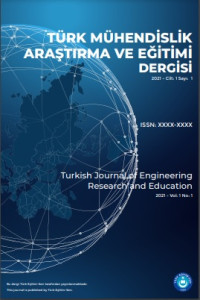Manyetik Rezonans Görüntülerinden Beyin Tümörü Tespitinde Sınıflandırma Algoritmalarının Karşılaştırmalı Analizi
MRG, beyin tümörü, sınıflandırma, destek vektör makinesi, rassal orman, makine öğrenmesi.
Comparative Analysis of Classification Algorithms in Brain Tumour Detection from Magnetic Resonance Images
MRI, brain tumour, classification, Support Vector Machine, Random Forest, machine learning.,
___
- N. Bhagat and G. Kaur, "MRI brain tumor image classification with support vector machine," Mater. Today: Proc., vol. 51, no. 8, pp. 2233-2244, 2022.
- P. Sutradhar, P. K. Tarefder, I. Prodan, M. S. Saddi and V. S. Rozario, "Multi-modal case study on MRG brain tumor detection using support vector machine, random forest, decision tree, k-nearest neighbor, temporal convolution transfer learning," AJSE, vol. 20, no. 3, pp. 107-117, Sep. 2021.
- S. N. Kumar, A. L. Fred, H. A. Kumar and P. S. Varghese, "Performance metric evaluation of segmentation algorithms for gold standard medical images," Recent Findings in Intelligent Computing Techniques, Springer, Singapore, Nov. 2018, pp. 457-469.
- P. Balabil, "Generative deep belief model for improved medical image segmentation," Intell. Autom. Soft Comput., vol. 35, no. 1, pp. 1-14, 2023.
- K. D. Babu and C. S. Singh, "Brain tumor segmentation through level based learning model," Comput. Syst. Sci. Eng., vol. 44, no. 1, pp. 709-720, 2023.
- R. Ghulam, S. Fatima, T. Ali, N. A. Zafar, A. A. Asiri, H. A. Alshamrani, S. M. Alqhtani and K. M. Mehdar, "A U-Net-based CNN model for detection and segmentation of brain tumor," Comput. Mater. Contin., vol. 74, no. 1, pp. 1333-1349, 2023.
- S. Sedlar, "Brain tumor segmentation using a multi-path CNN based method," Brainlesion: Glioma, Multiple Sclerosis, Stroke and Traumatic Brain Injuries, Lecture Notes in Computer Science, Springer, Cham, Feb. 2018, vol. 10670, pp. 403-422.
- Y.-X. Zhao, Y.-M. Zhang ve C.-L. Liu, "Bag of tricks for 3D MRG brain tumor segmentation," Brainlesion: Glioma, Multiple Sclerosis, Stroke and Traumatic Brain Injuries, Springer, Cham, May 2020, vol. 11992, pp. 210–220.
- H. Liu, G. Huo, Q. Li, X. Guan and M.-L. Tseng, "Multiscale lightweight 3D segmentation algorithm with attention mechanism: Brain tumor image segmentation," Expert Syst. Appl., vol. 214, pp. 119166, Mar. 2023.
- F. Behrad and M. S. Abadeh, "Evolutionary convolutional neural network for efficient brain tumor segmentation and overall survival prediction," Expert Systems with Applications, vol. 213, no. Part B, pp. 118996, 2023.
- S. Pereira, A. Pinto, V. Alves and C. A. Silva, "Brain tumor segmentation using convolutional neural networks in MRG images," IEEE Trans. Med. Imaging., vol. 35, no. 5, pp. 1240-1251, Mar. 2016.
- L. Anand, K. P. Rane, L. A. Bewoor, J. L. Bangare, J. Surve, M. P. Raghunath and S. Sankaran, "Development of machine learning and medical enabled multimodal for segmentation and classification of brain tumor using MRG images," Comput. Intell. Neurosci., pp. 7797094, Aug. 2022.
- B. Ragupathy, B. Subramani and S. Arumugam, "A novel approach for MR brain tumor classification and detection using optimal CNN-SVM model," Int. J. Imaging Syst. Technol., vol. 33, no. 2, pp. 746-759, Nov. 2022.
- J. Wu and H. Yang, "Linear regression-based efficient SVM learning for large-scale classification," IEEE Trans. Neural Netw. Learn. Syst., vol. 26, no. 10, pp. 2357-2369, Jan. 2015.
- The Chi squared tests., 1997. [Online]. Available: https://www.bmj.com/about-bmj/resources-readers/publications/statistics-square-one/8-chi-squared-tests.
- M. Nickparvar, "Brain Tumor MRG Dataset," 2021. Retrieved from https://www.kaggle.com/datasets/masoudnickparvar/brain-tumor-mri-dataset/metadata.
- ISSN: 2822-3454
- Başlangıç: 2022
- Yayıncı: Türk Eğitim-Sen
Ali ÖTELEŞ, İlker KÖPRÜ, Salih Hakan YETGİN
Murat Enes HATİPOĞLU, Fatih DİKMEN
Akıllı Staj Mobil Asistanı: Tasarım ve Geliştirme
Sinem ÇELİKTAŞ, Zeynep AKTÜRK, Özcan ÖZYURT
Geçirimli Beton Kaplamada Doğal Agreganın Taban Külü ile Kısmi ve Tam İkamesinin Etkileri
Zeinab NASSER EDDİNE, Firas BARRAJ, Jamal KHATİB, Adel ELKORDİ
Yeni Nesil Kablosuz Ağ Altyapılarında Yapay Zeka Kullanımı
Remzi GÜRFİDAN, Mevlüt ERSOY, Hilal KARTAL
Çelik Cürufu Kullanılan Yol Katmanlarında Geosentetik Tabaka Konumunun Etkisinin Belirlenmesi
Mürüvet ÖZSOY, Seyhan FIRAT, Nihat Sinan IŞIK, Berna UNUTMAZ
Oruç Altay KIRLI, Merve SANSARCI, Osman ÖZKARACA, Gürcan ÇETİN
